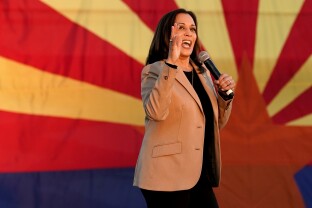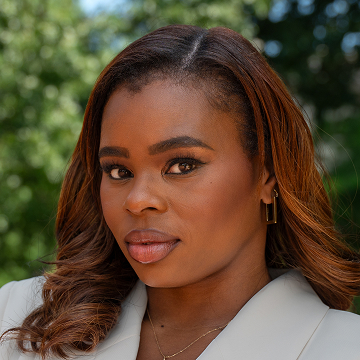Kamala Harris’ emergence as her party’s new presumed presidential nominee immediately renewed hope among Democrats that they could win a quartet of battleground “Sun Belt” states that had seemingly slipped out of reach for Joe Biden.
But Democratic strategists who spoke with NOTUS also have a strong warning: If Harris can’t keep the Midwestern “Blue Wall,” there’s no chance in hell the Sun Belt states would save her.
“If Democrats lose the Blue Wall, then they lose, period. No matter what happens in Georgia, Arizona, it’s just not gonna happen,” Atlanta-based political consultant Fred Hicks told NOTUS. “So they absolutely have to hold the Blue Wall, number one. Number two, you want to hold as many Sun Belt states as possible.”
The battleground Blue Wall — Michigan, Wisconsin and Pennsylvania — are three states that supported Donald Trump in 2016 after two decades of Democratic dominance before flipping for Biden in 2020. And early polling generally shows them being more favorable for Democrats than the four swing states considered part of the Sun Belt: North Carolina, Georgia, Nevada and Arizona.
Democratic strategists say they’re excited that Harris can expand on Biden’s 2024 electoral map, forcing Trump to spend time and money in states he must win. But any effort to win the Sun Belt, some of them caution, shouldn’t come at the expense of the trio of Midwestern battlegrounds.
“There’s no evidence, none — and I want to make this point very strongly — no evidence that all of the sudden Kamala Harris has a better chance in Georgia, Arizona and Nevada and her true path to the presidency is those states and not Michigan, Pennsylvania and Wisconsin,” Paul Maslin, a Democratic pollster currently working on Wisconsin Sen. Tammy Baldwin’s reelection campaign, told NOTUS. “Wrong, wrong, wrong, wrong, wrong,”
The Democratic debate over which battlegrounds to prioritize comes amid a broader upheaval in the presidential race, in which Biden’s exit and Harris’ ascension have reset the contest and reignited Democrats’ hopes that they can defeat Trump.
The former Republican president, whose lead against Biden ballooned after June’s debate, had until recently been talking about expanding his own electoral opportunities into places like Virginia and Minnesota, states that now might shift more firmly back into the Democratic column as Harris’ poll numbers improve on Biden’s across the board.
Some anti-Trump strategists continue to see the future of the Democratic Party moving south and slipping away from those Rust Belt states. States like Arizona and Georgia, which as recently as a decade ago were safe bets to go for the GOP presidential nominee, have trended toward the Democrats in recent years, driven by growing young and diverse voters who traditionally vote against Republicans.
“The old Blue Wall is perhaps too conservative a play. The Sun Belt is where the new Blue Wall is built, whether it’s this election or next election or elections going forward,” Mike Madrid, a GOP consultant specializing in Latino voters, told NOTUS. “It’s not driven by a candidate or momentum, it’s driven by a long-term trend.”
What’s unclear is how soon this predicted new Blue Wall could become a reality. There is reason to think that Harris at the top of the ticket could throw traditional electoral wisdom on the Sun Belt for a loop as soon as this election cycle.
While gaming the Electoral College math is not a new problem for Democrats — Republicans haven’t won the popular vote in a presidential election in two decades — Harris is a historic candidate, in terms of both her background and sudden circumstances.
For one, Kamala Harris is the first Black woman and first South Asian woman to lead a major U.S. party ticket. And Biden is the first president not to run for a second full term since Lyndon Johnson in the 1960s.
“We’re just in a completely different paradigm,” Adrianne Shropshire, the executive director of BlackPAC, told NOTUS. “There’s a lot to be reconsidered in this moment about what is possible.” BlackPAC is currently doing voter outreach in North Carolina, Pennsylvania, Michigan, Nevada and Wisconsin, but she said that could expand depending on resources.
“Lots of folks had some questions about whether or not Georgia was a competitive state this cycle with Biden at the top of the ticket. I think with Vice President Harris, it certainly should be considered as being back right on the map,” Shropshire said.
Harris herself reiterated as much to a Georgia audience last week. “The path to the White House runs right through this state,” Kamala Harris told her biggest rally yet in Atlanta, joined by artists Quavo and Megan Thee Stallion. “You all helped us win in 2020 and we’re going to do it again in 2024.”
Sen. JD Vance, the Republican vice presidential nominee, has also spent this week traveling through the Sun Belt, hitting Nevada and Arizona, and on Saturday appeared with Trump at the same Atlanta venue as Harris.
The Harris campaign is focused on seven battleground states. As Harris campaign chair Jen O’Malley Dillon recently wrote in a memo: “the Blue Wall states of Michigan, Wisconsin, and Pennsylvania — and the Sun Belt states of North Carolina, Georgia, Arizona and Nevada.” All except North Carolina were states Biden won in 2020.
Still, many Democratic strategists are skeptical about the Sun Belt. Democratic strategists in the traditional Blue Wall states say they think Harris retains as good a chance at winning a battleground like Pennsylvania as Biden did, even if the coalition of voters supporting her may look different. Mike Mikus, a Pennsylvania-based strategist, said he expects Harris to do worse than Biden in many of the state’s rural counties.
“But she gets more raw votes out of the cities of Pittsburgh and Philadelphia and kind of holds her own in the suburbs,” Mikus said. “So I think she wins but it’s just a different path.”
Maslin described to NOTUS the dread of watching any path to a Biden victory fade away in the polls in recent months. First, it became clear Georgia, Arizona and Nevada were all-but-gone for the president. Then, the death blow: polls regularly showing Biden trailing in Michigan, Wisconsin and Pennsylvania.
Now, with Harris at the top of the ticket, there’s an unmistakable collective sigh of relief among Democratic political strategists that there are more options than Biden’s unlikely road to 270 electoral votes. “The principal problem in Georgia, Arizona and Nevada were voters of color, and they probably skewed younger. That problem has been, if not solved, has been greatly reduced by the ascension of Kamala Harris,” Maslin said, adding that strategists were “apoplectic” about the wave of youth voters abandoning the party — some driven out by Biden’s support of Israel’s war in Gaza.
But even if that prediction bears out, he insists the tipping point in this election will still be the Rust Belt, and the rest of the battleground states are part of the electoral buffer zone.
“Democrats have problems with working-class white voters, and we are weaker than we’ve ever been. There’s no doubt about that,” Maslin said. “But I don’t think that Biden was somehow going to be some elixir here. He was already in deep, deep trouble. I don’t think Harris will fall any further with those groups. How much she gets back, that’s going to be a story yet to be told.”
—
Claire Heddles is a NOTUS reporter and an Allbritton Journalism Institute fellow. Alex Roarty is a reporter at NOTUS.
Sign in
Log into your free account with your email. Don’t have one?
Check your email for a one-time code.
We sent a 4-digit code to . Enter the pin to confirm your account.
New code will be available in 1:00
Let’s try this again.
We encountered an error with the passcode sent to . Please reenter your email.


